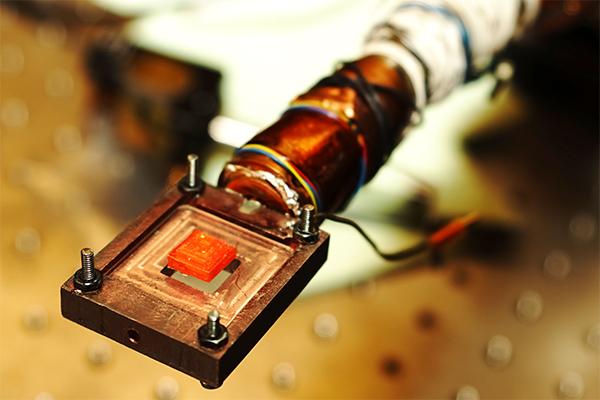Crystal light: New light-converting materials point to cheaper, more efficient solar power

This is a pure perovskite crystal, orange in colour, is mounted on a cryostat. Credit: U of T Engineering
University of Toronto engineers study first single crystal perovskites for new applications Engineers have shone new light on an emerging family of solar-absorbing materials that could clear the way for cheaper and more efficient solar panels and LEDs.
The materials, called perovskites, are particularly good at absorbing visible light, but had never been thoroughly studied in their purest form: as perfect single crystals.
Using a new technique, researchers grew large, pure perovskite crystals and studied how electrons move through the material as light is converted to electricity.
Led by Professor Ted Sargent of The Edward S. Rogers Sr. Department of Electrical & Computer Engineering at the University of Toronto and Professor Osman Bakr of the King Abdullah University of Science and Technology (KAUST), the team used a combination of laser-based techniques to measure selected properties of the perovskite crystals. By tracking down the rapid motion of electrons in the material, they have been able to determine the diffusion length–how far electrons can travel without getting trapped by imperfections in the material–as well as mobility–how fast the electrons can move through the material. Their work was published this week in the journal Science.
“Our work identifies the bar for the ultimate solar energy-harvesting potential of perovskites,” says Riccardo Comin, a post-doctoral fellow with the Sargent Group. “With these materials it's been a race to try to get record efficiencies, and our results indicate that progress is slated to continue without slowing down..”
In recent years, perovskite efficiency has soared to certified efficiencies of just over 20 per cent, beginning to approach the present-day performance of commercial-grade silicon-based solar panels mounted in Spanish deserts and on Californian roofs.
“In their efficiency, perovskites are closely approaching conventional materials that have already been commercialized,” says Valerio Adinolfi, a PhD candidate in the Sargent Group and co-first author on the paper. “They have the potential to offer further progress on reducing the cost of solar electricity in light of their convenient manufacturability from a liquid chemical precursor.”
The study has obvious implications for green energy, but may also enable innovations in lighting. Think of a solar panel made of perovskite crystals as a fancy slab of glass: light hits the crystal surface and gets absorbed, exciting electrons in the material. Those electrons travel easily through the crystal to electrical contacts on its underside, where they are collected in the form of electric current. Now imagine the sequence in reverse–power the slab with electricity, inject electrons, and release energy as light. A more efficient electricity-to-light conversion means perovskites could open new frontiers for energy-efficient LEDs.
Parallel work in the Sargent Group focuses on improving nano-engineered solar-absorbing particles called colloidal quantum dots. “Perovskites are great visible-light harvesters, and quantum dots are great for infrared,” says Professor Sargent. “The materials are highly complementary in solar energy harvesting in view of the sun's broad visible and infrared power spectrum.”
“In future, we will explore the opportunities for stacking together complementary absorbent materials,” says Dr. Comin. “There are very promising prospects for combining perovskite work and quantum dot work for further boosting the efficiency.”
Media Contact
All latest news from the category: Power and Electrical Engineering
This topic covers issues related to energy generation, conversion, transportation and consumption and how the industry is addressing the challenge of energy efficiency in general.
innovations-report provides in-depth and informative reports and articles on subjects ranging from wind energy, fuel cell technology, solar energy, geothermal energy, petroleum, gas, nuclear engineering, alternative energy and energy efficiency to fusion, hydrogen and superconductor technologies.
Newest articles

A ‘language’ for ML models to predict nanopore properties
A large number of 2D materials like graphene can have nanopores – small holes formed by missing atoms through which foreign substances can pass. The properties of these nanopores dictate many…

Clinically validated, wearable ultrasound patch
… for continuous blood pressure monitoring. A team of researchers at the University of California San Diego has developed a new and improved wearable ultrasound patch for continuous and noninvasive…

A new puzzle piece for string theory research
Dr. Ksenia Fedosova from the Cluster of Excellence Mathematics Münster, along with an international research team, has proven a conjecture in string theory that physicists had proposed regarding certain equations….



